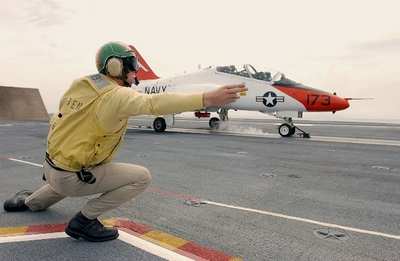Floating Airfield With Proud Name Soars
From Vulture’s
Row, perched high above the flight deck of USS Ronald
Reagan (CVN 76), all heads turned in the direction of the roar
of the oncoming jet. Together, the faces rotated in the opposite
direction, as the F/A-18 Hornet zoomed past. On the third pass, the
aircraft caught the wire. When it slowed to a stop and the noise of
the engine faded away, cheering could be heard from Vulture’s
Row down to the flight deck. This was the first step for the
recently commissioned ship in earning its Flight Deck Certification
(FDC).
The USS Ronald Reagan received its certification August
14 and will soon be joining the fleet as a fully-capable aircraft
carrier. For Aviation Boatswain’s Mate Airman (Handling)
Nathaniel Walters, it was the moment he was waiting for.
“I have been training for Flight Deck Certification ever
since I reported to Ronald Reagan almost two years
ago,” Walters said. “Not being FDC means that
we’re just a ship, just something floating out in the water.
With the certification, we can go anywhere in the world, whenever
we’re needed now, and do our part for the country.”
Lt. Cmdr. Scott Smith explained that an aircraft carrier
requires checks, known as bulletins.
“Aircraft launch bulletins determine where the catapult
officers set the catapult to launch aircraft. This setting changes
based on weight of aircraft, elongation of the catapult, air
temperature and wind-over-deck,” Smith said. “Aircraft
Recovery Bulletins determine arresting gear settings and
wind-over-deck requirements during normal and emergency
landings.”
Cmdr. Tom Quinn, assistant Air Department Officer, explained
that FDC is a two-part process.
“First, we have people come out and make sure that our
bulletins are correct. Then others come out and test us on how well
we can launch and recover aircraft,” said Quinn.

Other departments on the ship had tests to get ready for FDC, as
well. Airman Robert Boudreau works below the flight deck, making
sure fuel is clean before being sent up to aircraft.
“We’ve been doing some really intense training since
last week,” said Boudreau. “We pretend that something
happens, and we have to secure different valves. We simulate taking
the fuel to the flight deck, and have different scenarios of what
might happen.”
Another lesson learned from Ronald Reagan’s FDC
was that of vigilance. Part way through the certification, an
airman on watch noticed that part of the arresting gear
wasn’t working properly. Aviation Boatswain's Mate Airman
(Equipment) Jorge Linarez discovered excessive smoke and metal
shavings coming from the port side fairlead sheave. He alerted his
supervisor and called “foul deck” to prevent any
further landings while the problems were researched.
Lt. j.g. Kyle Caldwell explained that the fairlead sheave
assembly was not turning properly.
“When an aircraft lands on the flight deck, the cable is
fed out. What was happening here was the sheave wasn’t
turning,” Caldwell said. “That made the cable saw into
the hub. If it wasn’t noticed when it was, the cable could
have sawed right through the hub and (could) have been
severed.”
All 58 sheaves aboard were disassembled, the seals were removed
and lubricated and then reassembled - a job that takes about four
hours a sheave, according to Caldwell.
The ship returned to port to continue with the adjustments to
the arresting gear system and run tests with Naval Air System
engineers from Lakehurst (NJ). The ship was back at sea less than
two days later to continue the Flight Deck Certification
process.
“The Flight Deck Certification has been going well. The
rotation of the sheaves has improved 80 percent,” Caldwell
said. “It was a lot of hard work.”
The hard work paid off for Quinn when he watched the aircraft
land on the deck for the first time. “Seeing the Air
Department come together as a team was the best moment for me. It
was great to see young Sailors who thought cleaning and painting
was their only job realize that there is some fun in launching and
recovering aircraft.”
[ANN Thanks Journalist 3rd Class Megan Moline, USS Ronald
Reagan Public Affairs]
 ANN's Daily Aero-Linx (05.06.25)
ANN's Daily Aero-Linx (05.06.25) ANN's Daily Aero-Term (05.06.25): Ultrahigh Frequency (UHF)
ANN's Daily Aero-Term (05.06.25): Ultrahigh Frequency (UHF) ANN FAQ: Q&A 101
ANN FAQ: Q&A 101 Classic Aero-TV: Virtual Reality Painting--PPG Leverages Technology for Training
Classic Aero-TV: Virtual Reality Painting--PPG Leverages Technology for Training Airborne 05.02.25: Joby Crewed Milestone, Diamond Club, Canadian Pilot Insurance
Airborne 05.02.25: Joby Crewed Milestone, Diamond Club, Canadian Pilot Insurance



